Pity poor old HP. It's late to the 32-inch OLED gaming monitor market with the new Omen Transcend 32. Call us a little jaded, but it feels like we've seen it all before, what with our reviews of 4K OLEDs like the LG UltraGear 32GS95UE , Alienware 32 AW3225QF, Asus ROG Swift OLED PG32UCDM, Samsung Odyssey G8 OLED G80SD, or MSI MPG 321URX.
Ultimately, there are only two sources you can go to for the actual 32-inch 4K OLED panel, LG and Samsung. So, every monitor including this new HP is a derivation of one of those two familiar technical themes. What chance, then, that HP has come up with something individual and compelling?
Actually, the Omen Transcend 32 is pretty nice. The caveat is that it all hinges on price. Conceptually, HP has gone for a full-feature take on the 32-inch OLED riff. It's the full 240 Hz treatment, sports probably the best connectivity of any display in this class, and HP has included some additional capabilities claimed to make this a great display for content creation, too.
All of that would have you expecting a pretty painful price. And indeed the MSRP is a hefty $1,299. That's around $500 more than the MSI MAG 321UP, which sports essentially the same Samsung QD-OLED panel. The difference is that the MSI lacks true single-cable USB-C connectivity and also runs at 165 Hz.
HP Omen Transcend 32 OLED specs
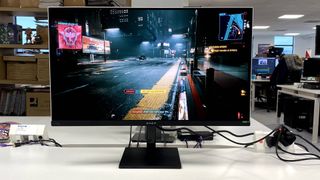
Screen size: 32-inch
Resolution: 3,840 x 2,160
Brightness: 250 nits full screen, 1,000 nits max HDR
Color coverage: 99% DCI-P3
Response time: 0.03 ms
Refresh rate: 240 Hz
HDR: DisplayHDR 400 True Black
Features: Samsung QD-OLED panel, Adaptive Sync, 1x DisplayPort 2.1, 2x HDMI 2.1, USB-C with 140W PD, KVM switch
Price: $999 | £1,199
However, you can actually buy this HP Omen for $999 from Best Buy, even at launch. In fact, Omen's own website links you through to Best Buy if you click "Shop Now", though the listing for the Omen Transcend 32 on the sister HP website allows you to buy direct for $1,299. Much will hinge on that disparity, but we'll come back to the sordid matter of money later.
To drill down into the specifics, then, this Omen monitor uses Samsung's latest QD-OLED 4K panel running at the aforementioned 240Hz and offering 0.03ms response times. In other words, it's hella quick.
It's rated at 250 nits full screen just like every other Samsung-equipped 32-inch 4K OLED, along with a peak of 1,000 nits for HDR content in a 3% window. Again, much of a muchness with other Samsung-based 4K OLEDs, albeit those are great specs.
The Transcend 32 begins to carve out something of a niche with its industrial design. The white rear section of the chassis is a little redolent of some Alienware and Samsung Odyssey panels. But there are a few signature Omen flourishes, such as the square base and slim stand. Overall, it looks pretty slick, though perhaps feels a little plasticky for such a premium panel.
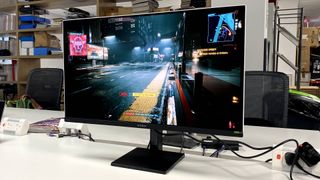
For the record, the display adjusts for height, tilt and rotate into portrait mode, but doesn't have any swivel support. There is also an invisible magnetic headphone hook on the left side of the panel for support headsets.
However, where the Transcend 32 really begins to separate itself from the competition involves connectivity. Along with the dual HDMI 2.1 and Display 2.1 ports, plus a USB hub with both USB-A and USB-C connectivity, most notable is the USB-C interface with DisplayPort Alt mode and 140 W of power delivery.
Yup, you read that right, 140 W. That's a fair bit higher than the usual 90 W and 100 W that USB-C interfaces top out at with most monitors. HP claims that it's enough to get a "full experience" with a single cable when gaming with their own Omen Transcend 14 gaming laptop.
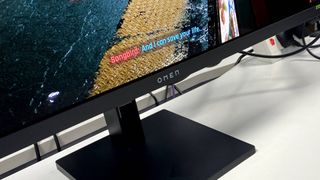
We suspect that's because the Transcend 14 can be had with a relatively low wattage Nvidia RTX 4060 GPU. Whatever, what we can say for sure is that in our testing with a Lenovo laptop equipped with an RTX 4080, the 140 W USB-C power delivery certainly wasn't enough for a "full experience". Using the USB-C only for power delivery cut the frame rate in half playing Cyberpunk 2077, but even the restriction in power usage that implies wasn't enough to prevent the battery being depleted during game play.
Anyway, the bottom line is that the 140 W USB-C interface almost certainly won't be enough to keep most gaming laptops juiced. But what it does allow for is a reasonably powerful laptop to be used alongside a gaming desktop. To that end, HP has included full KVM switch support.
Where the Transcend 32 really begins to separate itself from the competition involves connectivity.
It's also worth noting that, likely due to the high-spec USB-C interface, this monitor has easily the most massive power supply we've ever seen for a monitor. It's rated at 480 W and weighs a metric ton.
Connectivity aside, what of the Transcend 32's image quality? If there aren't really any surprises, we can confirm this is one of the better Samsung-based 32-inch 4K OLEDs we've seen. It's nicely calibrated in SRGB mode, but perhaps more importantly, SDR content actually looks its best and most punchy with HDR enabled.
That means you can simply select HDR and you're good to go with all kinds of content. It's also good to see that panel brightness is very consistent in all modes, with little if any evidence of brightness variability on the desktop depending on the content being shown. In other words, the panel's ABL or automatic brightness limiter is not at all intrusive.

That may be down to the graphene film panel heat sink and fan, with the latter operating pretty much inaudibly during our review. Anyway, this is as punchy a 4K QD-OLED as we've seen. It's also slightly less prone to the overly warm color balance that some QD-OLED's exhibit. Nice.
This is as punchy a 4K QD-OLED as we've seen.
Yes, you can still see the slightly grey, purplish tinge to the panel itself in very bright ambient light conditions. All QD-OLEDs suffer from that.
But it won't be an issue for most users and the general image quality, contrast and HDR performance is just fab.
The contrast and HDR visuals in particular benefit from a glossy coating that manages to really let the per-pixel OLED lighting pop while at the same time not being excessively prone to reflectivity. It's all nicely judged.
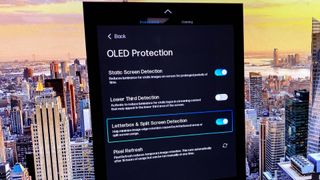
The net result is a pretty stellar gaming experience. Cyberpunk's ray-traced HDR visuals look utterly spectacular on the Transcend 32, while the 240Hz refresh and vanishingly short response times make for a very nippy experience in shooters like Counter-Strike 2. Of course, a 4K panel like this wouldn't be your first choice if you want the absolute last word in low latency and high frame rates. But if you're not a pretty serious esports type, there's more than enough speed on offer here.
Along with all that gaming goodness, this is a really lovely panel for more mundane desktop duties. The pixel density of the 4K native is much crisper and sharper than, say, a 27-inch 1440p or 34-inch ultrawide panel, for instance.
HP has also added a few features specifically for content creation pros, including configurable HDR clipping levels, manual or AV Info Frame HDR controls and factory calibration. We're likewise big fans of Omen's OSD controls. The interface is exceptionally logical, clear and easy to use and has all the features and options most users will want to see.
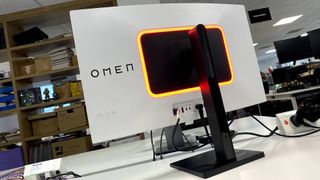
Oh, and HP has built in a quartet of downward firing speakers that perform comfortably above the norm. They're not going to displace even fairly basic dedicated speakers. But they produce decent audio in a pinch and are useful as a temporary backup.
The overall upshot, then, is that this is certainly one of the more appealing and better resolved 32-inch 4K OLEDs we've seen. Is it the best? That's hard to say. But one thing is for sure. Its appeal very much hinges on price.
Buy if...
✅ You want 4K OLED sizzle with great connectivity: HP's take on the 4K QD-OLED thing has the best connectivity of the lot.
Don't buy if...
❌ You want the most cost effective option: You can get basically the same QD-OLED panel for about $200 less.
At HP's $1,299 MSRP, we've not overly bothered. There are alternatives that can be had for $300 less that will deliver a similar experience. But at the $999 tag that's currently applied at Best Buy, the Transcend 32 is a different proposition.
In fact, if USB-C connectivity and sharing a monitor like this across a desktop gaming rig and a laptop is what you desire, then this Omen is probably our pick of the current bunch.
Of course, we could argue that if all you care about is exclusively gaming with your desktop and you don't mind forgoing 240Hz for 165Hz, the cheapest of the MSI options is the obvious pick. And if the $200 price differential is meaningful to you, then that absolutely makes sense.
But if you can afford the full $1,000, as an overall package in terms of its strong feature set and marginally superior image quality compared to cheaper alternatives, this HP Omen is probably worth the extra cash. It's certainly worthy of being on your 4K gaming OLED shortlist.

 3 weeks ago
11
3 weeks ago
11








 English (US) ·
English (US) ·